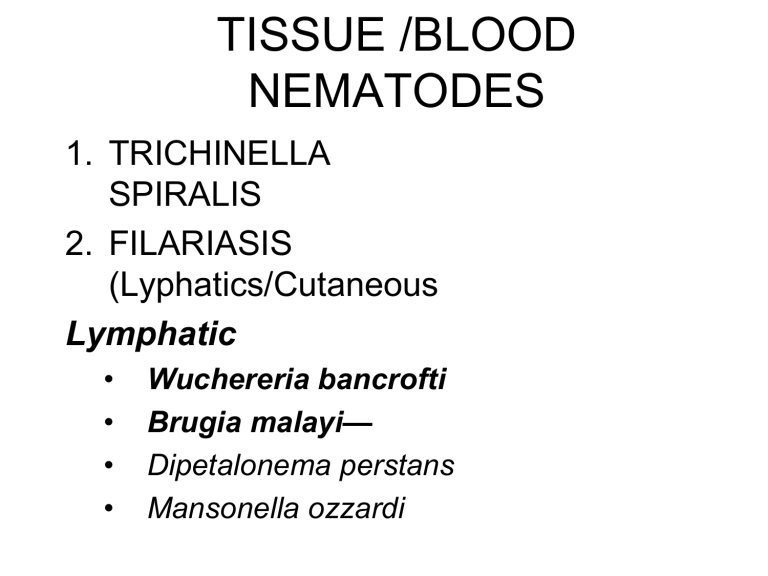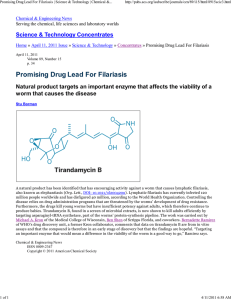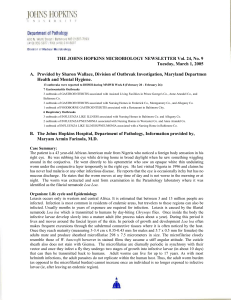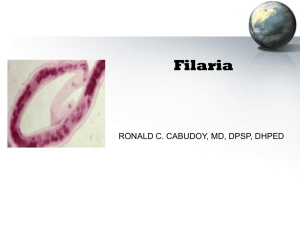
TISSUE /BLOOD NEMATODES 1. TRICHINELLA SPIRALIS 2. FILARIASIS (Lyphatics/Cutaneous Lymphatic • • • • Wuchereria bancrofti Brugia malayi— Dipetalonema perstans Mansonella ozzardi Filaria Worms • Nematodes which have successfully invaded the blood stream, connective tissue or serous cavities of vertebrates. • They are long thread –like nematodes • Filarial Disease Global Distribution Global Estemates 1 billion people in tropical and subtropical countries are exposed to the risk of filarial infections At least 200 million are infected with filariasis. The species which are primarily responsible for these human filarial infections are; Wuchereria bancrofti, Brugia malayi and Onchocerca volvulus. HUMAN FILARIASIS • SUPERFAMILY: FILARIOIDEA • FAMILY: FILARIIDAE 1.Lymphatic Filariasis – Wuchereria bancrofti – Brugia malayi— – Dipetalonema perstans – Mansonella ozzardi 2. Cutaneous Filariasis – Onchocerca vovulus – Loa loa Filarial Disease Elephantiasis the groin: Hydrocele Elephantiasi of limbs s • VULVULAR FILARIASIS River Blindness Disease In certain regions of West Africa, Onchocerciasis is a more important cause of blindness than trachoma. In some villages it is common to see young children leading blind adults; in highly endemic areas the blindness rate in men over 40 years may be 40% or higher.” Important Terms in Filarae studies 1.Microfilaria – Sheathed or – Unsheathed 2.Periodicity Nocturnal Sheathed microfilaria Microfilaria Microfilaria sheathed Microfilaria Lymphatic Filariasis 1. Wuchereria bancrofti: • • • • Adults found in lymphatic tissues Found below the diaphragm, Microfilariae are sheathed / Exhibit nocturnal periodicity through out worm climate (but not in South Pacific Lymphatic Filariasis 2. Brugia malayi • Common in East Asia, India etc. • Adults living in lymphatics, above diaphragm • Microfilariae are sheathed, • some strains are nocturnal. Cuteineous filariasis Cuteineous filariasis Onchocerca volvulus (River blindness): • Aldults live in subcutaneous tumors • Microfilariae are found through out • They are unsheathed. • Found in Tropical Africa (West Africa, Uganda, Sundan); Mexico, venezuela 2. Loa loa; Adults in cutaneous and subcutaneous migrating; Microfilariae unsheathed and nonperiodic. 3. Dipetalonema perstans 4 Mansonella ozzardi Cuteineous filariasis . 3. Dipetalonema perstans Mostly in Asia and cases in Africa (Congo Basin 4 Mansonella ozzardi Wuchereria bancrofti Adult worms: • These are Filariform worms with simple mouth, circular or somewhat dorsoventrally elongated. They have rudimentary bucal cavity and no lips • They live in tissue or body cavities of the human host • Female produce partially embryonated eggs • At the time of oviposition, the embryo uncoil to become snakelike microfilariae giving the egg the shape of an elongated sheath. Adult worms: • These are Filariform worms with simple mouth, circular or somewhat dorsoventrally elongated. They have rudimentary bucal cavity and no lips • They live in tissue or body cavities of the human host • Female produce partially embryonated eggs • At the time of oviposition, the embryo uncoil to become snakelike microfilariae giving the egg the shape of an elongated sheath. Adult worms: • . • The shell ruptures and the microfilariae are set free in the blood system, or they may remain in the blood in their sheathing (sheathed). • The microfilariae are ingested by arthropods from peripheral blood during feeding • The arthropod inject microfilariae into the next human host while taking the next blood meal. Filariasis Microfilaria Epidemiology: Where is Lymphatic Filariasis prevalent? Global Distribution of Lymphatic Filariasis: • 120 million people suffer from this disease in about 80 countries and 1.2 billion are at risk of being infected • 1/3 of the cases are in India, 1/3 are in Africa, and the rest are in Asia, the Pacific, and the Americas • However, 70% of cases are in India, Nigeria, Bangladesh, and Indonesia. • W. Bancroftian is found throughout Africa, southern and southeastern Asia, the Pacific islands, and the tropical and subtropical regions of South America and the Caribbean. • B. malayan filariasis occurs only in southern and southeastern Asia. Lifecycle: Wichereria bancrofti: is transmitted to man by Culex pipiens quinquefasciata, Aides aegypti, Anopheles gambiense etc which are ornthrophobic Development in man: • The infective stage after penetrating the skin pass through peripheral lymphatics and settle in lymphatic vessels where they mature and mate • Microfilariae discharged by recently mature female may appear in peripheral blood in 12 months • The adult worms in infected individual are tightly coiled in nodular lymphatic vessels or in the thoracic duct. Microfilaria Epidemiology: Man is inoculated by infected Culex mosqutoe when taking blood meal from the peripheral blood only during the night in endemic area. In highly endemic areas exposure begins early in childhood and continues throughout life. E.g. Prevalence of 33% was reported in endemic areas in persons over five year of age in Tahiti…In Kenya… • Symptoms/Pathogenicity: • Four stages – 3 to 12 months in which there are no symptoms. – The acute symptomatic stage with some swelling, pain, weakness of arms and legs, headache, insomnia. – Recovery which is permanent if reinfection does not occur. – If there is continued reinfection the cycle repeats and elephantiasis may result. • Worms restrict normal flow of lymph and result in swelling, fibrosis and eventually secondary infections in the affected tissues (usually legs and groin). Pathogenesis: (hydrocele and elephantiasis) Pathogenic effects of Wuchereria bancrofti are dependent on: Allergic manifestation due to inoculated larvae circulating through the lymphatic system Adult worms lodged in lymphatic vessels cause reticulo-endethelial response (immune response cells) in an attempt to destroy, engulf and absorb the worm. Pathogenesis: The endothelial lining of the lymphatic vessels become edematous and infiltrated with eosinophils. Fiberous tissue may form around the dead worm, or the worm may escape in to lymph nodes where again the node where again it will be surrounded by defense cells. This results in obliteration of lymphatic vessels and blockage of lymph flow (Accumulation of fluid ensues) Lymphangitis / or lymphadenitis may ensue and eventually veriscose groin gland (hydrocele) and elephantiasis DIAGNOSIS Patient history: • lymphatic filariasis causes dramatic enlargement of the leg, arm, and genitals (in women: the breast and vulva, and in men: the scrotum). • The adult worms also cause hidden internal damage to the kidneys and lymphatic system. • Diagnostic Tests • Blood sample, often collected at night because W. bancrofti comes out at night. • Antigen detection: There is also and ELISA test that looks for antigens of the parasite in the blood samples collected at any time of day. Diagnostic Tests • RAGFIL: Rapid Assessment of Geographical Distribution of bancroftian filariasis. • This technique is crucial to mapping lymphatic filariasis, especially in Africa and determine location of mass treatment programs. • The method uses spatial sampling grid to estimate geographical distribution of LF. Sampled villages are about 50 km apart. • Brugia malayi: microfilariae measure 270 by 8 µm, have a sheath and a tail with terminal constriction, elongated nuclei and absence of nuclei in the cephalic space. They have nocturnal periodicity. (Wet mount preparation). Treatment • Lymphatic filariasis: elephantiasis is the last consequence of the swelling of limbs and scrotum. • Diethylcarbamazine (DEC), ivermectine and albendazole used alone or in combination are the drugs of choice against microfilaria.. • DEC may slowly affect adult worms Ivermectine is effective to the microfilaria • National Lymphatic filaria control program in Kenya… Management of elephantiasis and hydrocyles…: Management of elephantiasis and hydrocyles…: • Antibiotics to prevent secondary infections. • Pressure bandages to reduce swelling. • Surgical removal of infected tissues to improve lymph flow. • Chemotherapy to kill circulating microfilariae • Vector (intermediate host) control. bm6: Brugia malayi: identification of microfilariae in stained smear is possible by observation of the stained sheath (W.bancrofti sheath does not stain). wb6: Microfilaria of Wuchereria bancrofti (Giemsa stain, x 400) 1. Cuteineous 1. 2. filariasis Oncerca vovulus Loa loa ONCHOCERCIASIS River blindness SUPERFAMILY: FILARIOIDEA FAMILY: FILARIIDAE • Onchocerciasis also known as River blindness, is the world's second leading infectious cause of blindness. • It is caused by Onchocerca volvulus, a nematode that can live for up to fifteen years in the human body. • It is transmitted to people through the bite of a black fly Simulium damnosum. • The worms spread throughout the body, and when they die, they cause intense itching and a strong immune system response that can destroy nearby tissue, such as the eye. • In certain regions of West Africa, Onchocerciasis is a more important cause of blindness than trachoma. In some villages it is common to see young children leading blind adults; in highly endemic areas the blindness rate in men over 40 years may be 40% or higher." Transcribed from the Atlas of Tropical and Extraordinary Diseases, p. 373. Photo contributed by WHO. • The primary treatment is a drug, ivermectin. For best effect, entire communities are treated at the same time. A single dose may kill first-stage larvae (microfilariae) in infected people and prevent transmission for many months in the remaining population. • About 18 million people are currently infected with this parasite; approximately 300,000 have been permanently blinded The life cycle of , a parasitic worm which causes river blindness Onchocerca volvulus microfilarial pathogen in its larval form. ONCHOCERCIASIS SKIN • The life cycle of O. volvulus begins when female black fly of the genus Simulium takes microfilariae stage of parasite in the dermis of an infected person during the blood meal • The microfilariae then penetrates the gut and migrates to thoracic flight muscles of the black fly, entering its first larval phase • After maturing into the second larval phase, it migrates to the proboscis where it can be found in the saliva.. • Saliva containing stage three of Onchocerca volvulus larvae passes into the blood of the second person during the next blood meal. Human stage: The larvae migrate to the subcutaneous tissue where they form nodules and mature into adult worms over a period of six to twelve months. • Adult male and female worms mate at the subcutaneous tissue. • Embryonated egg produce microfilaria • The female worm produce between 1,000 and 3,000 microfilariae per day. • The eggs mature internally to form stage one microfilariae, which are released from the female's body (viviposition) one at a time and remain in the subcutaneous tissue. • 1,000 to 3,000 microfilariae per day are produced . • • Stage one microfilariae are taken up by black flies upon a blood meal (infective stage), • They mature over the course of one to three weeks to stage three larvae, thereby completing the life cycle. • The normal microfilariae lifespan is 1–2 years • Humans are the only definitive host for O. volvulus.. Pathogenicity • Adult worms remain in subcutaneous nodules, limiting access to the host's immune system. • Microfilariae, in contrast, are able to induce intense inflammatory responses, especially upon their death. • Hosts’ innate immune responses and is associated with the disease morbidity. • Severity of illness is directly proportional to the number of microfilariae and the power of the resultant inflammatory response. Pathogenicity…2 Skin involvement typically consisting of intense itching, swelling, and inflammation. • Skin atrophy - loss of elasticity, skin resembles tissue paper, 'lizard skin' appearance; • Depigmentation - 'leopard skin' appearance, usually on anterior lower leg. • Ocular involvement provides the common name associated with onchocerciasis, river blindness.. • Pathogenicity…3 • The microfilariae migrate to the surface of the cornea, causing Punctate keratitis, hardening of tissue and making cornea opaque –blindness over time • Entire cornea may become opaque over time, thus leading to blindness. There is some evidence to suggest that the effect on the cornea is caused by an immune response to bacteria present in the worms. Treatment and control: COMMUNITY • Ivermectin (Mectizan);- infected people can be treated once every twelve months. • The drug paralyses the microfilariae and prevents them from causing itching. • Drug does not kill the adult worm, but prevent them from producing additional offspring. • Doxycycline can be added to the treatment regimen to lower microfilarial loads in the host and • Has activity against the adult worms. Control…International WHO Programmes Various control programs that aim to stop onchocerciasis from being a public health problem. • Larvicide spraying of fast flowing rivers to control black fly populations The first was the (OCP), which was launched in 1974 and at its peak covered 30 million people in eleven countries. • 1988 onwards Ivermectin introduced to treat infected people, The OCP eliminated onchocerciasis as a public health problem. Control… • The OCP, a joint effort of the World Health Organisation, the World Bank, the United Nations Development Programme and the UN Food and Agriculture Organization, was considered to be a success and came to an end in 2002. • Continued monitoring ensures that onchocerciasis cannot reinvade the area of the OCP. • In 1992 the (OEPA) was launched. The OEPA also relies on ivermectin. • In 1995 the (APOC) began covering another nineteen countries and mainly relying upon the use of ivermectin. • Its goal is to set up a community-directed supply of ivermectin for those who are infected. In these ways, transmission has declined. Resistance: worm may be developing resistance to ivermecti due to long period use, • Thank you & do get Loa loa • Since 1988, ivermectin has been provided free of charge by Merck & Sharp Co. through the (MDP). The MDP works together with ministries of health and nongovernmental development organisations such as the World Health Organization to provide free Mectizan to those who need it in endemic areas. Causes of morbidity Adult worms remain in subcutaneous nodules, limiting access to the host's immune system. Microfilariae, in contrast, are able to induce intense inflammatory responses, especially upon their death. Dying microfilariae have been recently discovered to release Wolbachia-derived antigens, triggering innate immune responses and producing the inflammation and its associated morbidity. Severity of illness is directly proportional to the number of microfilariae and the power of the resultant inflammatory response. Causes of morbidity; Skin involvement typically consists of intense itching, swelling, and inflammation. A grading system has developed to categorize the degree of skin involvement: 1. Acute papular dermatitis - scattered pruritic papules; 2. Chronic papular dermatitis - larger papule, resulting in hyperpigmentation; 3. Lichenified dermatitis - hyperpigmented papules and plaques, with eodema, lymphadenopathy, pruritus and common secondary bacterial infections; • Skin atrophy - loss of elasticity, skin resembles tissue paper, 'lizard skin' appearance; • Depigmentation - 'leopard skin' appearance, usually on anterior lower leg. • Ocular involvement provides the common name associated with onchocerciasis, river blindness. The microfilariae migrate to the surface of the cornea. • Punctate keratitis occurs in the infected area. This clears up as the inflammation subsides. • Chronic infection, sclerosing (scaring-hardening of tissue) keratitis can occur, making the affected area become opaque. • Over time the entire cornea may become opaque, thus leading to blindness. There is some evidence to suggest that the effect on the cornea is caused by an immune response to bacteria present in the worms. • Treatment and control: The treatment for onchocerciasis is ivermectin (Mectizan); • Infected people can be treated once every twelve months. • The drug paralyses the microfilariae and prevents them from causing itching. In addition, while the drug does not kill the adult worm, it does prevent them from producing additional offspring. • The drug therefore prevents both morbidity and transmission. Treatment and control…2 • Doxycycline (An adjuvant) can be added to the treatment regimen to kill the endosymbiotic bacteria, Wolbachia. • This adjuvant therapy has been shown to significantly lower microfilarial loads in the host and may have activity against the adult worms Global effort for control:. • Since 1988, ivermectin has been provided free of charge by Merck &Sharp Co. through the (MDP). • The MDP works together with ministries of health and nongovernmental development organisations such as the World Health Organization to provide free Mectizan to those who need it in endemic areas. • Global effort for control There are various control programs that aim to stop onchocerciasis from being a public health problem. • The first was the (OCP), which was launched in 1974 and at its peak covered 30 million people in eleven countries. • Through the use of larvicide spraying of fast flowing rivers to control black fly populations and, from 1988 onwards, the use of ivermectin to treat infected people, the OCP eliminated onchocerciasis as a public health problem. The OCP, a joint effort of the World • Global effort for control: The OCP, a joint effort of the World, the use of ivermectin to treat infected people, the OCP eliminated onchocerciasis as a public health problem. • The OCP, a joint effort of the World Health Organisation, the World Bank, the United Nations Development Programme and the UN Food and Agriculture Organization, was considered to be a success and came to an end in 2002. • Continued monitoring to ensures that onchocerciasis cannot reinvade the area of the OCP. In 1995 the (APOC) began covering another nineteen countries and mainly relying upon the use of ivermectin. Its goal is to set up a community-directed supply of ivermectin for those who are infected. In these ways, transmission has declined. • According to a study in the British medical journal The Lancet, the worm may be developing resistance to ivermecti LOA LOA (EYE WORM) LOA LOA (Eye worm) Vector:Deer fly (Chrysops silacae) LOA LOA (EYE WORM) Loa loa CLASS: SECERNENTEA • • • • SUPERFAMILY: FILARIOIDEA FAMILY: ONCHOCERCIDAE Loa loa Common name - eye worm • Hosts: humans Distribution • Rain forest areas of West Africa and equatorial Sudan Life Cycle • Adults live in subcutaneous tissues. • Microfilariae are periodic (in peripheral blood during day, in lungs at night). • Intermediate host is Deer fly (Chrysops). • Symptoms/Pathogenicity: • Adults tend to wander through the subcutaneous connective tissues. • "Calabar swellings," appear when the worms are still and disappear when the worms move on. • Adults also migrate through the conjuctiva and cornea causing swelling of the orbit with psychosomatic results to the host. (Eye worm) • Diagnosis is by finding microfilariae in blood. LOA LOA (EYE WORM) LOA LOA (EYE WORM) Management: • Diagnosis is by finding microfilariae in blood. • Surgical removal of swellings (worm). • Treatment-- Surgical Removal of the worm • Control of deer flies is difficult because breeding areas are widespread. • Drancunculus medinensis Dracunculiasis is a disease caused by the parasitic worm Dracunculus medinensis or "Guinea-worm". This worm is the largest of the tissue parasite affecting human. The parasite is transmitted by fresh-water arthropods known as copepods ("water fleas-" Cyclops) • Dracunculus medinensis: The Guinea Worm • Biology and Epidemiology • Distribution • Dracunculus medinensis, commonly known as guinea-worm is a parasite of the dog, horse, cow, wolf, leopard, monkey, and baboon that also commonly infects man. The majority of human infections occur in parts of West Africa, East Africa, and India. • Life Cycle • The guinea-worm like all filarial nematodes goes through six developmental stages. The however unlike any other filarial parasite that can be transmitted to humans the infective larvae enter • Humans become infected by drinking unfiltered water containing copepods (small crustaceans) which are infected with larvae of Drancunculus medinensis Morphology/life cycle: 1 • Following ingestion by humans in drinking water, the copepods is digested on arrival at duodenum. Larvae are released and migrate through the stomach and the intestinal wall and reach the loose connective tissue, the retroperitoneal space usually. They develop into adults in eight to 12 months. • The adult female, which carries about 3 million embryos, can measure 70 to 120 cm in length and 2 mm in diameter. • The parasite migrates through the victim's subcutaneous tissues causing severe pain especially when it occurs in the joints. • The worm eventually emerges (from the feet in 90% of the cases), causing an intensely painful oedema, • A blister and ulcer will form at this point of exit. Fever, nausea and vomiting are usually experienced during this time Morphology/life cycle: 2 After maturation into adults and copulation, the male worms die and the females (length: 70 to 120 cm) migrate in the subcutaneous tissues towards the skin surface . • Approximately one year after infection, the female worm induces a blister on the skin, generally on the distal lower extremity, which ruptures. Morphology/life cycle: 3 • The larvae are ingested by a copepod and after two weeks (and two molts) have developed into infective larvae . Ingestion of the copepods closes the cycle . • When this lesion comes into contact with water, a contact that the patient seeks to relieve the local discomfort, the female worm emerges and releases larvae . • Morphology/life cycle: 4 The worms are elongated cylindroidal cords, bluntly rounded at the anterior end and recurved at the caudal end to anchor them in position In measurements, males are about 45 45 mm long and …………. Females are 70 to 120 cm long by 0.9 to 1.7mm in diameter. The ovarian tubules, oviduct and uteri are paired. In gravid females the uteri are highly coiled, distended mass filled with rhabditoid larvae and occupy the greater part of the body Control • There is no vaccine or medicine to treat or prevent Guinea worm disease. Once a Guinea worm emerges a person must wrap the live worm around a piece of gauze or a stick to extract it from the body. This long, painful process can take up to a month. • This is the same treatment that is noted in the famous ancient Egyptian medical text, the Ebers papyrus from 1550 B.C.. Some people have said that extracting a Guinea worm feels like they are being stabbed or that the afflicted area is on fire. • Although Guinea worm disease is usually not fatal, the wound where the worm emerges could develop a secondary bacterial infection such as tetanus, which may be life-threatening—a concern in endemic areas where there is typically limited or no access to health care.Analgesics can be used to help reduce swelling and pain and antibiotic ointments can help prevent secondary infections at the wound site. Epidemiology Human infection results fro swallowing raw water cantaining infected cyclops The cyclops become infected when the gravid female worms discharge their larval progeny into the water where the cyclops breed.



